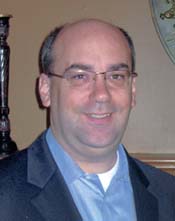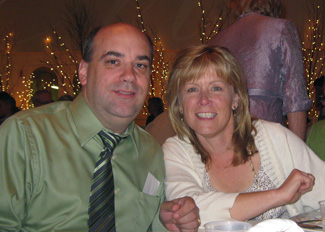 |
 |
| current issue |  | past issues |  | send a letter/news |  | address update |  | advertise |  | about us |  | alumni home |
Features
|
The First UROP Grant Recipients
Where are they now? |
Return to The First UROP Grant Recipients |
Daniel J. Therrien '88
Major: mechanical engineering
Job title: Project manager, Office of Construction and Facilities Management, Veterans Affairs
Hometown: Kenosha, Wis.
 Daniel J. Therrien '88 |
What have you been doing since graduation, and what are you doing now?
I joined the Navy after graduation, but as I often joke, I didn't join the Navy to go to sea. I served in the Navy Civil Engineer Corps, doing facility construction and maintenance at a number of Navy bases around the world. I started as a project manager overseeing building renovations, and as I was promoted through the years I was afforded opportunities for increased responsibility. By the end of my Navy career, I was the director of public works for a cluster of Navy bases, where I was responsible for providing utilities (running a power plant and a sewage treatment facility), performing building maintenance, and overseeing new construction projects, with an annual budget of several million dollars and over 600 employees working for me.
Like the old saying goes—join the Navy and see the world—or parts of it, at least. During my Navy career, I spent time in California, Louisiana, Pennsylvania, and Virginia, plus overseas locations including Japan, Iceland, Cuba, and Korea. I earned two master's degrees—one in Mechanical Engineering and another in Business. I also obtained my Professional Engineering license. More rewardingly, I spent some time volunteering with Habitat for Humanity. I'm currently involved in helping set up a local Habitat chapter where I live.
Today, I work as a project manager for the Department of Veterans Affairs, in the Office of Construction and Facilities Management. In my current assignment, I am overseeing the design and construction of a new, $845 million, 1.6 million square foot medical center campus in New Orleans, to replace the old VA Medical Center which was destroyed during Hurricane Katrina.
My wife of 24 years, Pam, and I have two wonderful daughters. We live in Wisconsin now, and we enjoy taking family bike rides along the shore of Lake Michigan—rides that often end at the local ice cream parlor. Pam volunteers at school so much that she is occasionally mistaken as an employee, and I serve on the governance board for the charter high school which our older daughter attends.
Your UROP project was entitled "Design and Construction of a Strain Gage Load Cell." Can you tell us what you did, and what you got out of it?
The "load cell" is technically a dynamometer, or essentially a fancy scale. It consisted of a mounting adapter with some internal devices to measure the force being applied to a piece of metal as it underwent the end milling process—the commercial metal fabrication equivalent of a woodworker's router. The idea was to feed information back to the milling machine about how much force was being applied to the workpiece, so that a controller on the milling machine could be adjusted to keep the force constant, because a constant force results in a smoother finished product.
As is typical for most academic research projects, my research partner, Scott Wudyka, and I spent a lot of time reading and studying and doing math. We came up with lots of ideas for the design, many of which turned out to be not very good ideas. At least we knew enough to dismiss the bad ideas before going down too many wrong roads. But the real fun started after we finally settled on the design. Getting the pieces fabricated in the metal shop, applying those tiny strain gages - desperately trying not to ruin them (they were the most expensive component of the load cell), soldering (and re-soldering) connections on the circuit board... the kinds of things we hadn't done before the project started but had an absolute blast figuring out.
 Daniel Therrien and wife Pam. |
I still remember the "eureka" moment on this project like it was yesterday. We didn't have a milling machine at our disposal, but we needed some way to figure out if the load cell could measure force being applied to it. So after finally building the thing and wiring it up to the oscilloscope, late one evening in the lab, exhausted and frustrated, I jumped up on the table, stood on the load cell, and shook my whole body back and forth. Lo and behold, a sign wave showed up on the screen! I screamed at the top of my lungs for Woody (Scott's nickname) to load paper into the machine and start recording the output. It worked! It actually worked!
At the time, getting the load cell to work seemed to be the pinnacle for the project. Looking back on it several years later, however, the most important lessons I learned were completely independent of that outcome. Ralph Waldo Emerson was right, "life is a journey, not a destination." Taking missteps along the way, and more importantly refusing to accept failure and taking action to correcting those missteps, was immensely more instructive. As a practical example, we were convinced that we needed 48 strain gages for our load cell. Gages don't initially appear to be expensive—just $5 each - but when you need 50+ of them (we figured a few of the gage applications would go awry) it adds up quickly. We racked our brains for weeks, trying to reduce the number of gages required, in order to lower the cost and the amount of effort needed to apply them. I don't remember how many configurations we considered and rejected, but eventually we found a way to cut the requirement in half - we only needed 24 gages. Even if we'd ended up needing all 48 gages, it was the process of figuring out the solution that mattered.
Did your research have an impact on what you did later?
The research itself didn't, but the research process certainly had tremendous impact on me. In the end, it wasn't about the science, it was about people. During the course of the project, we met with and talked to several people, including a local metal shop owner who we convinced to fabricate—at no cost—our stainless plate steel into the parts we used to construct the load cell, and an engineer at a strain gage manufacturing company who gave us a great deal of valuable advice on dynamometer design. Engineers and scientists are often stereotyped as socially inept, humorless creatures working alone in a lab, with little-to-no outside interests. But I have found that in reality, the most successful engineers—much like the most successful folks in other professions—tend to be warm, friendly folks, with a sense of humor, who enjoy doing lots of things other than math.
What do you remember about being on the cover of the Alumnus (assuming you remember it)?
Not only do I remember it, I still have a copy of it! The things I do in life - whether at work, or volunteering, or even in my private life—I do because I believe they're the right things to do. I don't do them for the recognition. And maybe that's why I'm rarely, if ever, in the limelight. I will never be on the cover of Rolling Stone, but I was on the cover of the New Hampshire Alumnus once upon a time. So while I don't go out of my way seeking recognition, it's still nice to be recognized, and that cover has always said to me that somebody noticed what I was doing and thought that it was something good. A little validation goes a long way in my book.
Anything else you'd like to add? Any advice for current students?
One of the most valuable lessons I've learned—in practical matters at least—is the importance of good writing. All the hard work required for a successful project will go for naught unless you can write something explaining clearly and convincingly why it's a good idea in the first place. Every decision that needs to be made, every approval that needs to be granted, every dollar that needs to be allocated... none of it happens without somebody writing a request. So go out there and make your dreams happen. Don't let anybody tell you that you can't do it. Just be sure to write it down.
< Previous recipient Next recipient >
Back to the '88 UROP stories
blog comments powered by Disqus

